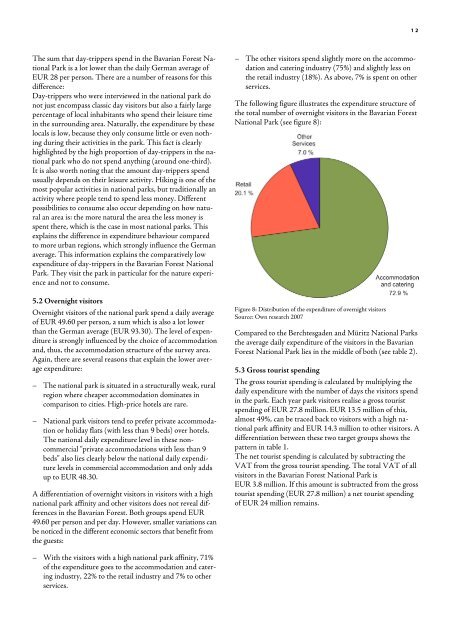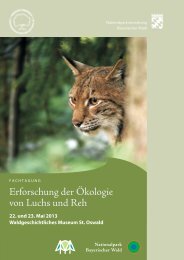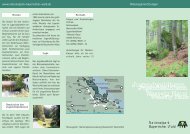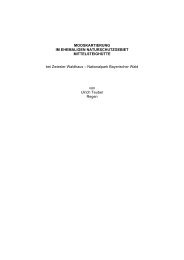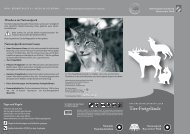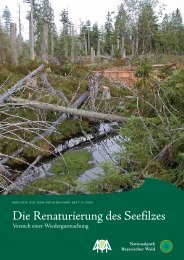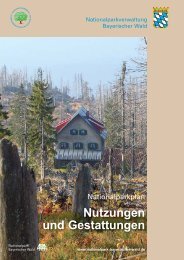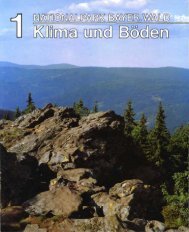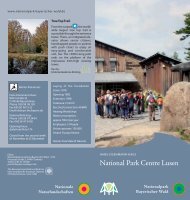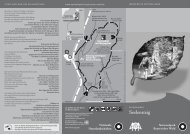The regional economic impact of Bavarian Forest National Park
The regional economic impact of Bavarian Forest National Park
The regional economic impact of Bavarian Forest National Park
Create successful ePaper yourself
Turn your PDF publications into a flip-book with our unique Google optimized e-Paper software.
<strong>The</strong> sum that day-trippers spend in the <strong>Bavarian</strong> <strong>Forest</strong> <strong>National</strong><br />
<strong>Park</strong> is a lot lower than the daily German average <strong>of</strong><br />
EUR 28 per person. <strong>The</strong>re are a number <strong>of</strong> reasons for this<br />
difference:<br />
Day-trippers who were interviewed in the national park do<br />
not just encompass classic day visitors but also a fairly large<br />
percentage <strong>of</strong> local inhabitants who spend their leisure time<br />
in the surrounding area. Naturally, the expenditure by these<br />
locals is low, because they only consume little or even nothing<br />
during their activities in the park. This fact is clearly<br />
highlighted by the high proportion <strong>of</strong> day-trippers in the national<br />
park who do not spend anything (around one-third).<br />
It is also worth noting that the amount day-trippers spend<br />
usually depends on their leisure activity. Hiking is one <strong>of</strong> the<br />
most popular activities in national parks, but traditionally an<br />
activity where people tend to spend less money. Different<br />
possibilities to consume also occur depending on how natural<br />
an area is: the more natural the area the less money is<br />
spent there, which is the case in most national parks. This<br />
explains the difference in expenditure behaviour compared<br />
to more urban regions, which strongly influence the German<br />
average. This information explains the comparatively low<br />
expenditure <strong>of</strong> day-trippers in the <strong>Bavarian</strong> <strong>Forest</strong> <strong>National</strong><br />
<strong>Park</strong>. <strong>The</strong>y visit the park in particular for the nature experience<br />
and not to consume.<br />
5.2 Overnight visitors<br />
Overnight visitors <strong>of</strong> the national park spend a daily average<br />
<strong>of</strong> EUR 49.60 per person, a sum which is also a lot lower<br />
than the German average (EUR 93.30). <strong>The</strong> level <strong>of</strong> expenditure<br />
is strongly influenced by the choice <strong>of</strong> accommodation<br />
and, thus, the accommodation structure <strong>of</strong> the survey area.<br />
Again, there are several reasons that explain the lower average<br />
expenditure:<br />
– <strong>The</strong> national park is situated in a structurally weak, rural<br />
region where cheaper accommodation dominates in<br />
comparison to cities. High-price hotels are rare.<br />
– <strong>National</strong> park visitors tend to prefer private accommodation<br />
or holiday flats (with less than 9 beds) over hotels.<br />
<strong>The</strong> national daily expenditure level in these noncommercial<br />
“private accommodations with less than 9<br />
beds” also lies clearly below the national daily expenditure<br />
levels in commercial accommodation and only adds<br />
up to EUR 48.30.<br />
A differentiation <strong>of</strong> overnight visitors in visitors with a high<br />
national park affinity and other visitors does not reveal differences<br />
in the <strong>Bavarian</strong> <strong>Forest</strong>. Both groups spend EUR<br />
49.60 per person and per day. However, smaller variations can<br />
be noticed in the different <strong>economic</strong> sectors that benefit from<br />
the guests:<br />
– With the visitors with a high national park affinity, 71%<br />
<strong>of</strong> the expenditure goes to the accommodation and catering<br />
industry, 22% to the retail industry and 7% to other<br />
services.<br />
– <strong>The</strong> other visitors spend slightly more on the accommodation<br />
and catering industry (75%) and slightly less on<br />
the retail industry (18%). As above, 7% is spent on other<br />
services.<br />
<strong>The</strong> following figure illustrates the expenditure structure <strong>of</strong><br />
the total number <strong>of</strong> overnight visitors in the <strong>Bavarian</strong> <strong>Forest</strong><br />
<strong>National</strong> <strong>Park</strong> (see figure 8):<br />
Figure 8: Distribution <strong>of</strong> the expenditure <strong>of</strong> overnight visitors<br />
Source: Own research 2007<br />
12<br />
Compared to the Berchtesgaden and Müritz <strong>National</strong> <strong>Park</strong>s<br />
the average daily expenditure <strong>of</strong> the visitors in the <strong>Bavarian</strong><br />
<strong>Forest</strong> <strong>National</strong> <strong>Park</strong> lies in the middle <strong>of</strong> both (see table 2).<br />
5.3 Gross tourist spending<br />
<strong>The</strong> gross tourist spending is calculated by multiplying the<br />
daily expenditure with the number <strong>of</strong> days the visitors spend<br />
in the park. Each year park visitors realise a gross tourist<br />
spending <strong>of</strong> EUR 27.8 million. EUR 13.5 million <strong>of</strong> this,<br />
almost 49%, can be traced back to visitors with a high national<br />
park affinity and EUR 14.3 million to other visitors. A<br />
differentiation between these two target groups shows the<br />
pattern in table 1.<br />
<strong>The</strong> net tourist spending is calculated by subtracting the<br />
VAT from the gross tourist spending. <strong>The</strong> total VAT <strong>of</strong> all<br />
visitors in the <strong>Bavarian</strong> <strong>Forest</strong> <strong>National</strong> <strong>Park</strong> is<br />
EUR 3.8 million. If this amount is subtracted from the gross<br />
tourist spending (EUR 27.8 million) a net tourist spending<br />
<strong>of</strong> EUR 24 million remains.


